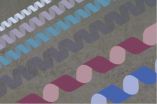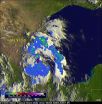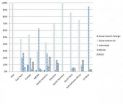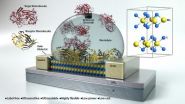(Press-News.org) Caffeine therapy for apnea of prematurity has no long-term harmful effects on sleep or control of breathing, according to a new study of 201 preterm children assessed at ages 5-12, the first study in humans to examine the long-term effects of neonatal caffeine treatment on sleep regulation and ventilatory control.
"Animal studies have suggested that administration of neonatal caffeine to premature infants, while improving survival and other outcomes, may have long-term detrimental effects on sleep and control of breathing during sleep," said lead author Carole L. Marcus, MBBCh, of Children's Hospital of Philadelphia. "In our prospective follow-up study of 201 premature infants who participated as infants in the randomized, double-blind, placebo-controlled Caffeine for Apnea of Prematurity study, we found no evidence of long-term detrimental effects of caffeine treatment on sleep duration or sleep apnea during childhood."
The findings were published online ahead of print publication in the American Thoracic Society's American Journal of Respiratory and Critical Care Medicine.
At follow-up, the 201 study participants, 98 of whom received caffeine as infants, underwent two weeks of actigraphy, which measures sleep versus wakefulness based on movement, along with one night of home polysomnography to detect sleep-related medical conditions. Caregivers completed sleep diaries and questionnaires.
There were no significant differences between children who received caffeine or placebo as infants in actigraphic total sleep time or in the apnea hypopnea index, which indicates sleep apnea severity based on the number of apneas (complete cessation of airflow) and hypopneas (partial cessation of airflow) per hour of sleep. Polysomnographic sleep efficiency did not significantly differ between the caffeine and placebo groups at follow-up; nor did the percentage of children with obstructive sleep apnea or elevated periodic limb movements of sleep.
Interestingly, the study also showed that the prevalence of children with obstructive sleep apnea syndrome (9.6 percent) and/or elevated periodic limb movements of sleep in the pathologic range (14.2 percent) in the study population overall, regardless of whether or not they received caffeine treatment, was much higher than population estimates for school-age children, which range from 1 to 4 percent for sleep apnea and 5 to 8 percent for elevated periodic limb movements of sleep.
"Administration of therapeutic caffeine to premature infants had no long-term negative effects on sleep or sleep disorders in our study," said Dr. Marcus. "Ex-preterm infants, whether treated with caffeine or not, have a higher than expected prevalence at school age of obstructive sleep apnea syndrome and periodic limb movements during sleep."
"This data should help ease concerns about the long-term effects of caffeine treatment in premature infants."
INFORMATION:
About the American Journal of Respiratory and Critical Care Medicine
With an impact factor of 11.986, the AJRRCM is a peer-reviewed journal published by the American Thoracic Society. It aims to publish the most innovative science and the highest quality reviews, practice guidelines and statements in the pulmonary, critical care and sleep-related fields.
Founded in 1905, the American Thoracic Society is the world's leading medical association dedicated to advancing pulmonary, critical care and sleep medicine. The Society's 15,000 members prevent and fight respiratory disease around the globe through research, education, patient care and advocacy.
Caffeine therapy for apnea of prematurity does not have long-term harmful effects on sleep
2014-09-05
ELSE PRESS RELEASES FROM THIS DATE:
Research finds no association between wearing a bra and breast cancer
2014-09-05
PHILADELPHIA — A population-based case-control study found no association between bra wearing and increased breast cancer risk among postmenopausal women, according to research published in Cancer Epidemiology, Biomarkers & Prevention, a journal of the American Association for Cancer Research.
"There have been some concerns that one of the reasons why breast cancer may be more common in developed countries compared with developing countries is differences in bra-wearing patterns," said Lu Chen, MPH, a researcher in the Public Health Sciences Division at Fred Hutchinson ...
Magnetic nanocubes self-assemble into helical superstructures
2014-09-05
Materials made from nanoparticles hold promise for myriad applications, from improved solar energy production to perfect touch screens. The challenge in creating these wonder-materials is organizing the nanoparticles into orderly arrangements.
Nanoparticles of magnetite, the most abundant magnetic material on earth, are found in living organisms from bacteria to birds. Nanocrystals of magnetite self-assemble into fine compass needles in the organism that help it to navigate.
Collaborating with nanochemists led by Rafal Klajn at the Weizmann Institute of Science in Israel, ...
A lifetime of outdoor activity may contribute to common eye disease; sunglasses may help
2014-09-04
BOSTON (Sept. 4, 2014) — Residential geography, time spent in the sun, and whether or not sunglasses are worn may help explain why some people develop exfoliation syndrome (XFS), an eye condition that is a leading cause of secondary open-angle glaucoma and can lead to an increased risk of cataract and cataract surgery complications, according to a study published on Sept. 4 in JAMA, Ophthalmology.
Despite improvements in understanding the cause of this common yet life-altering condition, more work needs to be done. "The discovery that common genetic variants in the lysyl ...
NASA sees Dolly's remnants bringing showers to the Rio Grande Valley
2014-09-04
Tropical Storm Dolly fizzled out quickly on September 3 after making landfall in eastern Mexico, and NASA's Aqua satellite saw some of the remnants moving into southern Texas. NASA's TRMM satellite analyzed the rainfall occurring in the storm as it was approaching landfall.
NASA's Aqua satellite captured the remnants of Tropical Depression Dolly over northeastern Mexico on Sept. 3 at 19:40 UTC (3:40 p.m. EDT). The image, captured by the Moderate Resolution Imaging Spectroradiometer or MODIS instrument showed the center of Dolly over northeastern Mexico with a band of thunderstorms ...
Hurricane Norbert pinwheels in NASA satellite imagery
2014-09-04
The Eastern Pacific's Hurricane Norbert resembled a pinwheel in an image from NASA's Terra satellite as bands of thunderstorms spiraled into the center. NASA's Global Precipitation Measurement or GPM mission has helped forecasters see that Norbert has lost some of its organization early on September 4.
The MODIS instrument or Moderate Resolution Imaging Spectroradiometer aboard NASA's Terra satellite captured a visible picture of Tropical Storm Norbert on Sept. 4 at 2:15 p.m. EDT when it resembled a pinwheel. The western bands of Norbert were moving over Socorro Island, ...
Climate-smart agriculture requires three-pronged global research agenda
2014-09-04
Faced with climate change and diminishing opportunities to expand productive agricultural acreage, the world needs to invest in a global research agenda addressing farm and food systems, landscape and regional issues and institutional and policy matters if it is to meet the growing worldwide demand for food, fiber and fuel, suggests an international team of researchers.
In a paper appearing online in the journal Agriculture and Food Security, the authors summarize the findings of the second international Climate Smart Agriculture conference held in March 2013 at UC Davis.
"Climate-smart ...
News media losing role as gatekeepers to new 'social mediators' on Twitter, study finds
2014-09-04
The U.S. government is doing a better job of communicating on Twitter with people in sensitive areas like the Middle East and North Africa without the participation of media organizations, according to a study co-authored by a University of Georgia researcher.
The study looked at the U.S. State Department's use of social media and identified key actors who drive its messages to audiences around the world. In particular, it examined the role played by news media and the government in bridging the State Department communication with people domestically and internationally. ...
Scientists identify rare stem cells that hold potential for infertility treatments
2014-09-04
DALLAS – Sept. 4, 2014 – Rare stem cells in testis that produce a biomarker protein called PAX7 help give rise to new sperm cells — and may hold a key to restoring fertility, research by scientists at UT Southwestern Medical Center suggests.
Researchers studying infertility in mouse models found that, unlike similar types of cells that develop into sperm, the stem cells that express PAX7 can survive treatment with toxic drugs and radiation. If the findings hold true in people, they eventually could lead to new strategies to restore or protect fertility in men undergoing ...
Sugar substitutes not so super sweet after all
2014-09-04
The taste of common sugar substitutes is often described as being much more intense than sugar, but participants in a recent study indicated that these non-nutritive sugar substitutes are no sweeter than the real thing, according to Penn State food scientists.
In the study, participants compared the taste of non-nutritive sweeteners that are often used as low- or no-calorie sugar substitutes with those of nutritive sweeteners, such as sugar, maple syrup and agave nectar. The participants indicated they could perceive the non-nutritive sweeteners -- such as aspartame, ...
UCSB researchers develop ultra sensitive biosensor from molybdenite semiconductor
2014-09-04
Move over, graphene. An atomically thin, two-dimensional, ultrasensitive semiconductor material for biosensing developed by researchers at UC Santa Barbara promises to push the boundaries of biosensing technology in many fields, from health care to environmental protection to forensic industries.
Based on molybdenum disulfide or molybdenite (MoS2), the biosensor material — used commonly as a dry lubricant — surpasses graphene's already high sensitivity, offers better scalability and lends itself to high-volume manufacturing. Results of the researchers' study have been ...





